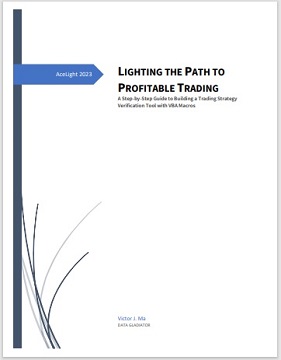From Passive to Contrarian: A Guide to Stock Market Buying Strategies
|
|
Are you ready to dive into the world of stock market buying strategies?
Buckle up, because things are about to get exciting! Just kidding, we all
know that investing in the stock market can be about as thrilling as
watching paint dry. But hey, that doesn't mean it's not important. In fact,
choosing the right buying strategy can mean the difference between retiring
on a beach somewhere or retiring in your parents' basement. So, let's put on
our thinking caps and take a look at some of the most popular stock market
buying strategies out there. Get ready to feel like a Wall Street pro (or at
least a slightly more informed novice)!
The stock market is one of
the most dynamic and exciting places to invest your money. But for those new
to the game, it can also be incredibly daunting. The sheer number of stocks,
the endless fluctuations, and the constantly changing economic landscape can
make it difficult to know where to start. That's why it's crucial to have a
solid buying strategy in place. In this blog, we'll discuss some of the most
popular stock market buying strategies and how to use them to make informed
decisions.
1. Value Investing
Value investing is a long-term
investment strategy that involves identifying undervalued companies with
strong fundamentals. The goal is to find stocks that are trading at a
discount to their intrinsic value and hold them until the market recognizes
their true worth.
To identify undervalued stocks, value investors
look at a company's financial metrics such as its price-to-earnings ratio
(P/E ratio), price-to-book ratio (P/B ratio), and dividend yield. They also
analyze the company's balance sheet, income statement, and cash flow
statement to get a better understanding of its financial health.
For
example, Warren Buffet is one of the most famous value investors of all
time. He built his fortune by investing in undervalued companies such as
Coca-Cola, American Express, and Wells Fargo.
2. Growth Investing
Growth investing is a strategy that focuses on buying stocks of
companies with high growth potential. These companies typically reinvest
their profits back into the business to fuel growth, rather than paying
dividends to shareholders.
Growth investors look for companies with
strong earnings growth, a competitive advantage, and a large addressable
market. They also pay attention to macro trends that could drive demand for
the company's products or services.
One example of a growth stock is
Amazon. In the early 2000s, Amazon was a relatively unknown e-commerce
company. But by reinvesting profits back into the business and expanding
into new markets, Amazon has become one of the largest companies in the
world.
3. Momentum Investing
Momentum investing is a strategy
that involves buying stocks that have recently performed well and selling
stocks that have recently performed poorly. The idea behind this strategy is
that stocks that have been going up will continue to go up, and stocks that
have been going down will continue to go down.
Momentum investors
typically look at a stock's price trends, trading volume, and other
technical indicators to identify stocks that are in an uptrend. They also
pay attention to market sentiment and news events that could impact a
stock's price.
One example of a momentum stock is Tesla. In 2020,
Tesla's stock price surged more than 700% as investors bet on the company's
growth potential in the electric vehicle market.
4. Income Investing
Income investing is a strategy that focuses on buying stocks that pay a
high dividend yield. This strategy is popular among retirees and other
investors who are looking for steady income from their investments.
To identify high dividend yield stocks, income investors typically look at a
company's dividend history, payout ratio, and financial stability. They also
pay attention to the company's sector and any regulatory or economic factors
that could impact its ability to pay dividends.
One example of an
income stock is AT&T. AT&T has a long history of paying dividends and
currently has a dividend yield of around 7%.
5. Index Investing
Index investing is a strategy that involves buying a basket of stocks
that tracks a specific market index, such as the S&P 500 or the Dow Jones
Industrial Average. The goal of index investing is to achieve market returns
with minimal effort and cost.
Index investors typically invest in
exchange-traded funds (ETFs) or mutual funds that track the desired index.
By investing in a diversified portfolio of stocks, index investors can
reduce their risk and take advantage of the long-term growth potential of
the stock market.
One advantage of index investing is that it's a
passive strategy. Unlike other strategies that require active stock picking,
index investing involves simply buying and holding a diversified portfolio
of stocks. This means that index investors don't need to spend time
researching individual companies or monitoring their investments on a daily
basis.
Another advantage of index investing is that it's low cost.
ETFs and mutual funds that track market indexes typically have low expense
ratios compared to actively managed funds. This means that index investors
can keep more of their investment returns and minimize the impact of fees on
their portfolio.
6. Contrarian Investing
Contrarian investing
is a strategy that involves buying stocks that are out of favor with the
market. The idea behind this strategy is that the market tends to overreact
to both positive and negative news, creating opportunities for contrarian
investors to buy low and sell high.
Contrarian investors typically
look for stocks that are trading at a discount to their intrinsic value,
have a low P/E ratio, and have been oversold by the market. They also pay
attention to market sentiment and news events that could impact a stock's
price.
One example of a contrarian stock is Microsoft in the early
2000s. At the time, Microsoft was facing antitrust lawsuits and was seen as
a slow-growing company. But contrarian investors who bought Microsoft stock
during this period were rewarded as the company rebounded and became one of
the most valuable companies in the world.
7. Dollar-Cost Averaging
Dollar-cost averaging is a strategy that involves investing a fixed
amount of money at regular intervals, regardless of the stock's price. This
strategy helps to reduce the impact of market volatility on an investor's
portfolio.
For example, let's say an investor wants to invest $10,000
in a particular stock. Instead of investing all of the money at once, the
investor could invest $1,000 per month over a 10-month period. This would
help to smooth out the impact of short-term price fluctuations and reduce
the overall cost basis of the investment.
Dollar-cost averaging is a
popular strategy for investors who are looking to build long-term wealth
without taking on excessive risk. It's also a good strategy for investors
who are just starting out and don't have a lot of capital to invest.
 No
matter how perfect a trading strategy works in theory, we need to test it
before we really use it in the market. These tests include back-testing and
forward-testing. The same one stock trading strategy works for different
stock and uses different parameters, there will be hundreds or even
thousands of different results. We need some methods and tools to verify
which trading strategy works well for which stock, and under what
conditions. Our tutorial handbook is offering some methods and tools to
execute these testing and verifying tasks. You can download it for free. By using these testing
methods, traders can gain valuable insights into the performance of their
strategies and make adjustments as needed to optimize their results. So, if
you want to succeed in the stock market, make sure to prioritize testing
before putting your capital at risk. For more information, Click
LIGHTING THE PATH TO PROFITABLE TRADING: A Step-by-Step Guide to Building a Trading Strategy Verification Tool with VBA Macros to get the whole tutorial handbook for free! No
matter how perfect a trading strategy works in theory, we need to test it
before we really use it in the market. These tests include back-testing and
forward-testing. The same one stock trading strategy works for different
stock and uses different parameters, there will be hundreds or even
thousands of different results. We need some methods and tools to verify
which trading strategy works well for which stock, and under what
conditions. Our tutorial handbook is offering some methods and tools to
execute these testing and verifying tasks. You can download it for free. By using these testing
methods, traders can gain valuable insights into the performance of their
strategies and make adjustments as needed to optimize their results. So, if
you want to succeed in the stock market, make sure to prioritize testing
before putting your capital at risk. For more information, Click
LIGHTING THE PATH TO PROFITABLE TRADING: A Step-by-Step Guide to Building a Trading Strategy Verification Tool with VBA Macros to get the whole tutorial handbook for free!
And click Free Trial to download strategies testing tools, all for a 30-day Free Trial.
Click on Subscription to order more strategies testing tools to help your stock trading.
Well, we've covered a lot of ground today, from passive index
investing to active stock picking to dollar-cost averaging. I hope you're
feeling inspired to take charge of your investments and start making smart
choices in the stock market. And if you're still feeling overwhelmed, just
remember this: even the most experienced investors don't have all the
answers. In fact, some of the most successful investors out there have made
mistakes, learned from them, and come out stronger on the other side. So
don't be afraid to take a few risks, learn from your mistakes, and maybe
even have a little fun along the way. Hope we might have a chance to retire
on that beach after all. Who knows? Good luck, happy trading!
|


|

Free Tutorial
Share
|
|
|
|